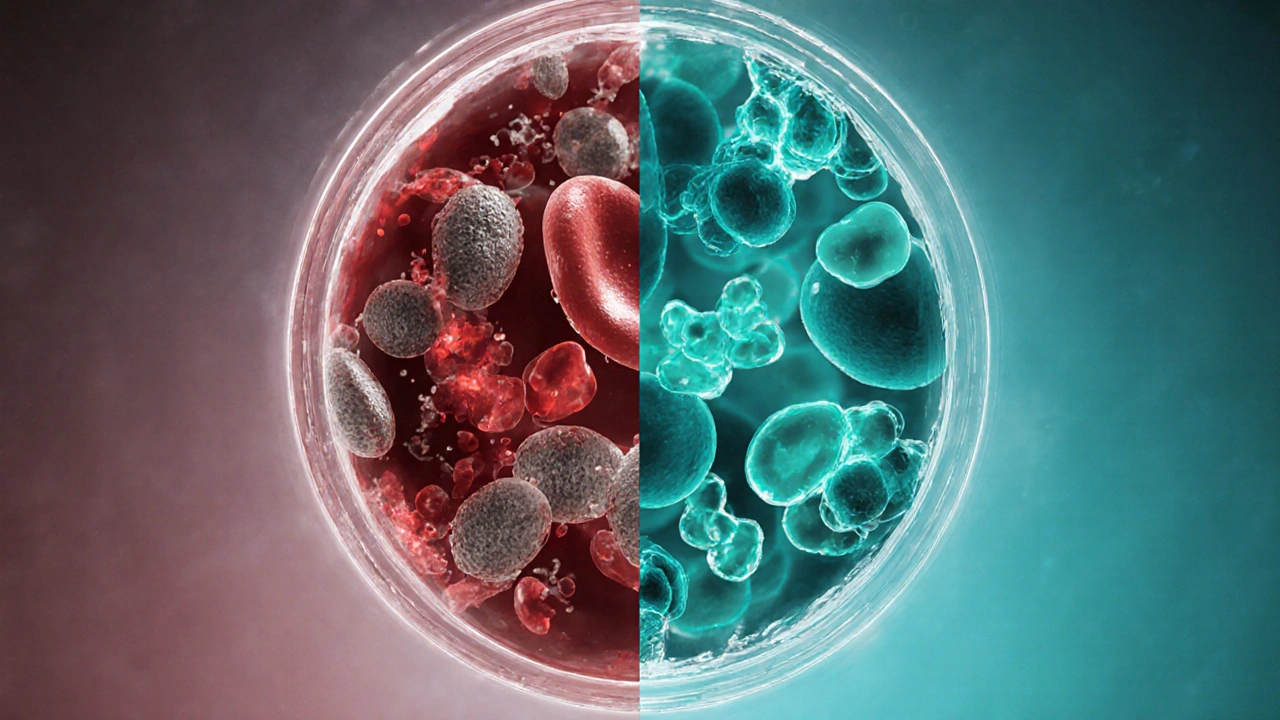Retrovir vs Alternative HIV Drugs Comparison
Retrovir (Zidovudine)
Moderate Side Effects Blood-related Low Cost
- First FDA-approved HIV drug (1987)
- NRTI with proven efficacy
- Twice daily dosing
- Can cause anemia and neutropenia
Newer Alternatives
Mild Side Effects Once daily Moderate Cost
- Tenofovir + Emtricitabine (Truvada)
- Abacavir + Lamivudine (Epzicom)
- Once daily dosing
- Better tolerability
Side Effect Comparison
Retrovir (AZT)
- Common: Anemia, Neutropenia
- Rare but serious: Lactic Acidosis
- Gastrointestinal upset
- Muscle weakness
Newer NRTIs
- Minimal: Nausea, Headache
- Less risk of blood disorders
- Better tolerability
- Renal considerations
Resistance Profile
Retrovir (AZT)
- Single mutation resistance common
- Can overcome with boosted regimens
- Lower genetic barrier
Newer Agents
- Higher genetic barrier to resistance
- Multi-drug resistance less likely
- More durable response
Cost Considerations
Retrovir (Generic)
- Very affordable ($2-5/month)
- Generic availability
- Lowest cost option
Newer Regimens
- Insurance coverage available
- Depends on plan
- Potential assistance programs
Key Takeaways
- Retrovir (Zidovudine) is an older NRTI with proven efficacy but notable blood‑related side effects.
- Newer NRTIs such as Tenofovir and Emtricitabine offer better tolerability and once‑daily dosing.
- Resistance patterns differ: AZT‑resistance can be overcome with boosted regimens, while some alternatives have higher genetic barrier.
- Cost in 2025 varies by country; generic Azidothymidine remains cheap, but newer agents may be covered by insurance schemes.
- Choosing the right backbone depends on patient comorptions, pregnancy status, and renal function.
When a clinician or patient looks at HIV treatment options, the first question is often “Should I stay on Retrovir or switch to something newer?” This article breaks down the science, side‑effect profile, resistance data, and real‑world cost of Retrovir (Zidovudine) and the most common alternatives on the market today.
What is Retrovir (Zidovudine)?
Retrovir (Zidovudine) is a nucleoside reverse transcriptase inhibitor (NRTI) that was the first drug approved for HIV infection in 1987. Its chemical name is 3′‑azido‑2′,3′‑dideoxythymidine, often abbreviated AZT. The drug works by mimicking the natural nucleoside thymidine, getting incorporated into viral DNA and terminating the growing chain. Over four decades of use have built a deep safety and efficacy database, but the drug’s age also means it carries some legacy concerns.
How Retrovir Works - The NRTI Mechanism
The HIV reverse transcriptase enzyme copies viral RNA into DNA. NRTIs like Retrovir act as false building blocks. When reverse transcriptase adds the AZT molecule, the azido group at the 3′‑position prevents the addition of the next nucleotide, halting DNA synthesis. This “chain‑termination” effect blocks the virus from integrating into host cells.
Typical Dosing and Administration
Retrovir is taken orally, usually 300mg twice daily, with food to reduce gastrointestinal upset. For patients with renal impairment, the dose is adjusted based on creatinine clearance: a 50% reduction is common for CrCl<30mL/min. The drug reaches steady‑state concentrations in about five days, so clinicians monitor viral load after two weeks of therapy.
Efficacy and Resistance Profile
Clinical trials from the 1990s showed a median viral load reduction of 1.5log copies/mL when Retrovir was used in a dual‑therapy backbone. Modern combination regimens that include a boosted protease inhibitor or an integrase strand transfer inhibitor (INSTI) can still achieve Retrovir‑based suppression rates above 90% in adherent patients.
Resistance emerges mainly through mutations at the reverse transcriptase codons 41, 67, 70, 215, and 219 (e.g.,M41L,T215Y). Because AZT has a relatively low genetic barrier, clinicians often add a second NRTI or a high‑potency companion drug to prevent breakthrough.

Side‑Effect Profile
The most frequently reported adverse events are hematologic:
- Macrocytic anemia (up to 10% of patients)
- Neutropenia (5‑7%)
- Thrombocytopenia (rare)
Non‑hematologic reactions include nausea, headache, and mild liver enzyme elevations. Long‑term myopathy has been described, especially when combined with other mitochondrial‑toxicity agents.
Alternatives on the Market (2025)
Several NRTIs have entered the clinic since AZT’s debut. Below is a snapshot of the most widely used alternatives, each defined with its own microdata block on first mention.
Tenofovir disoproxil fumarate (TDF) is a nucleotide reverse transcriptase inhibitor (NtRTI) that provides once‑daily dosing and a high barrier to resistance. Its common dose is 300mg daily.
Emtricitabine (FTC) is an NRTI often paired with TDF in the fixed‑dose combination Truvada. It is dosed at 200mg daily and shares a favorable safety profile.
Abacavir (ABC) is a guanosine analogue NRTI used at 600mg daily. It carries a risk of hypersensitivity syndrome, screened via HLA‑B*57:01 testing before initiation.
Lamivudine (3TC) is an NRTI with a long history of tolerability, dosed at 300mg daily. It often forms the backbone of dual‑NRTI regimens.
Dolutegravir (DTG) is an integrase strand transfer inhibitor (INSTI) that, while not an NRTI, is frequently combined with NRTI backbones for modern first‑line therapy. Its once‑daily 50mg dose offers a high genetic barrier to resistance.
Side‑by‑Side Comparison
| Drug | Class | Typical Dose | Key Side Effects | Resistance Barrier | 2025 Generic Price (USD per month) |
|---|---|---|---|---|---|
| Retrovir (Zidovudine) | NRTI | 300mg BID | Anemia, neutropenia, nausea | Low | ~$12 |
| Tenofovir disoproxil fumarate | NtRTI | 300mg QD | Renal toxicity, bone density loss | Moderate | ~$20 |
| Emtricitabine | NRTI | 200mg QD | Usually well‑tolerated, rare hypersensitivity | Moderate | ~$18 |
| Abacavir | NRTI | 600mg QD | Hypersensitivity (HLA‑B*57:01), cardiovascular risk | High | ~$25 |
| Lamivudine | NRTI | 300mg QD | Mild GI upset, rare lactic acidosis | Moderate | ~$15 |
Choosing the Right Backbone - Decision Guide
Clinicians weigh three core factors when picking an NRTI combo:
- Patient comorbidities: Renal disease tips the scale toward Abacavir (if HLA‑B*57:01 negative) or Lamivudine; anemia or baseline low hemoglobin makes AZT less attractive.
- Pregnancy considerations: Zidovudine remains the only NRTI with a strong safety record in pregnancy, while Tenofovir is now considered safe but still monitored closely.
- Adherence potential: Once‑daily regimens (TDF/FTC, ABC/3TC) improve pill‑burden and are preferred for patients with unstable schedules.
When resistance testing shows an M184V mutation (confers high‑level resistance to Lamivudine and Emtricitabine), clinicians often keep the drug for its “viral fitness” cost to HIV and add a higher‑barrier companion like Dolutegravir.
Cost and Access in 2025
Global pricing varies dramatically. In high‑income markets, generic AZT drops to under $15 per month, while brand‑name Tenofovir‑based combos hover around $30‑$40. Low‑ and middle‑income countries benefit from the WHO’s pre‑qualification program, bringing TDF/FTC down to $10‑$12 per month in bulk. Insurance coverage in NewZealand’s PHARMAC scheme currently lists Retrovir as a subsidized option for patients with documented anemia risk when newer agents are contraindicated.
Practical Tips for Clinicians and Patients
- Baseline labs: CBC, renal panel, and HLA‑B*57:01 before starting AZT or ABC.
- Monitoring schedule: CBC every 2weeks for the first month on AZT, then monthly for three months.
- Switch strategy: If anemia develops, consider swapping AZT for TDF/FTC while maintaining the same third agent.
- Adherence aids: Fixed‑dose combos (e.g., Truvada) reduce missed doses by 25% compared with separate pills.
- Drug-drug interactions: Avoid concomitant use of didanosine with AZT due to overlapping mitochondrial toxicity.

Frequently Asked Questions
Is Retrovir still recommended for first‑line HIV therapy?
Guidelines in 2025 list AZT‑based regimens as an alternative rather than a preferred first‑line option. It remains useful for pregnant patients or when cost constraints limit access to newer drugs.
What causes the anemia associated with Zidovudine?
AZT interferes with mitochondrial DNA synthesis in red‑blood‑cell precursors, leading to macrocytic anemia. The effect is dose‑dependent and usually reversible after dose reduction or discontinuation.
Can I switch from AZT to Tenofovir without changing my other drugs?
In most cases yes, provided the companion drug does not have overlapping renal toxicity. Monitor creatinine clearance after the switch and adjust dose if needed.
How does resistance to AZT develop?
Resistance arises through mutations at reverse transcriptase positions 41, 67, 70, 215, and 219. These changes reduce AZT incorporation or enhance excision of the drug from viral DNA.
Is there a generic version of Retrovir available worldwide?
Yes. Generic zidovudine is produced in India, China, and several Eastern European countries, making it the lowest‑cost option in most generic drug programs.


Sonia Michelle
October 3, 2025 AT 10:11When you weigh the cheap price of Retrovir against its blood‑related side effects, the trade‑off becomes a philosophical question about what we value in therapy. The drug’s legacy data are solid, but the anemia and neutropenia risk can be a heavy burden for patients already dealing with comorbidities. I argue that in settings where monitoring is reliable, the low cost can justify staying on AZT, especially for people without renal issues. Yet, for anyone who can access once‑daily regimens, the quality‑of‑life boost is hard to ignore. So the decision should be both evidence‑based and patient‑centered.
Neil Collette
October 8, 2025 AT 01:17Oh, look, another “cost‑effective” miracle pill that makes you feel like you’re sipping blood from a rusty pipe. Retrovir’s two‑daily dosing is practically a workout routine, and the anemia? Just a free ticket to the “I‑feel‑like‑a‑zombie” club. Meanwhile, the shiny newer NRTIs promise painless mornings and a single pill a day-how utterly boring! If you enjoy living on the edge of a hospital lab, stick with AZT; otherwise, grab that modern combo and pretend you’ve evolved.
James Lee
October 12, 2025 AT 16:24Clearly, anyone still trumpeting AZT is stuck in the stone age.
Dennis Scholing
October 17, 2025 AT 07:31While I respect the emotive phrasing, it is essential to acknowledge that the clinical data supporting Zidovudine remain robust. The cost considerations you mention are indeed salient, particularly in low‑resource environments where generic availability ensures access. Nevertheless, the risk of hematologic toxicity warrants vigilant monitoring, a point that should not be dismissed lightly. In practice, the choice between a legacy agent and a newer formulation depends on a careful assessment of patient‑specific factors, including renal function and adherence potential. Therefore, a balanced appraisal is advisable.
Kasey Lauren
October 21, 2025 AT 22:37Hey folks, just wanted to say that it’s great we have options-whether you go with the cheap Retrovir or the newer once‑daily meds, the most important thing is staying on treatment and feeling good.
joshua Dangerfield
October 26, 2025 AT 13:44i totally get that staying on retrovir can be a solid choice if u got good doc support, but dont forget newer pills can make life a lot easier. once a day dosing means less hassle and less chance to miss a dose, which is super important for long term success. also, many insurances are covering those newer combos, so cost ain't always a barrier. just keep an eye on kidney stuff and talk to ur doc about what works best.
Abhimanyu Singh Rathore
October 31, 2025 AT 04:51Indeed, the pharmacokinetic profile of Zidovudine is well‑documented; however, one must not overlook the profound impact of modern nucleos(t)ide analogues on patient adherence-!!! Moreover, the once‑daily regimens dramatically reduce pill burden, thereby enhancing quality of life; yet, the financial implications remain variable, contingent upon insurance formularies-!!! In short, both efficacy and tolerability must be weighed meticulously.
Stephen Lewis
November 4, 2025 AT 19:57In response to the preceding observation, it is pertinent to emphasize that the evaluation of antiretroviral regimens should be grounded in a comprehensive risk‑benefit analysis. While cost considerations are undeniably significant, the paramount objective remains virologic suppression with minimal adverse events. Accordingly, clinicians are advised to individualize therapy based on the patient’s clinical profile, comorbid conditions, and socioeconomic context.
janvi patel
November 9, 2025 AT 11:04Contrary to the prevailing enthusiasm for newer agents, there are scenarios where an older backbone such as AZT remains the most pragmatic option, especially when drug‑drug interactions limit the use of tenofovir‑based combinations.
Lynn Kline
November 14, 2025 AT 02:11Absolutely spot‑on! 🌟 The way you highlighted the balance between cost and side‑effects is both insightful and encouraging-keep shining that light for those navigating complex treatment decisions! 🎉